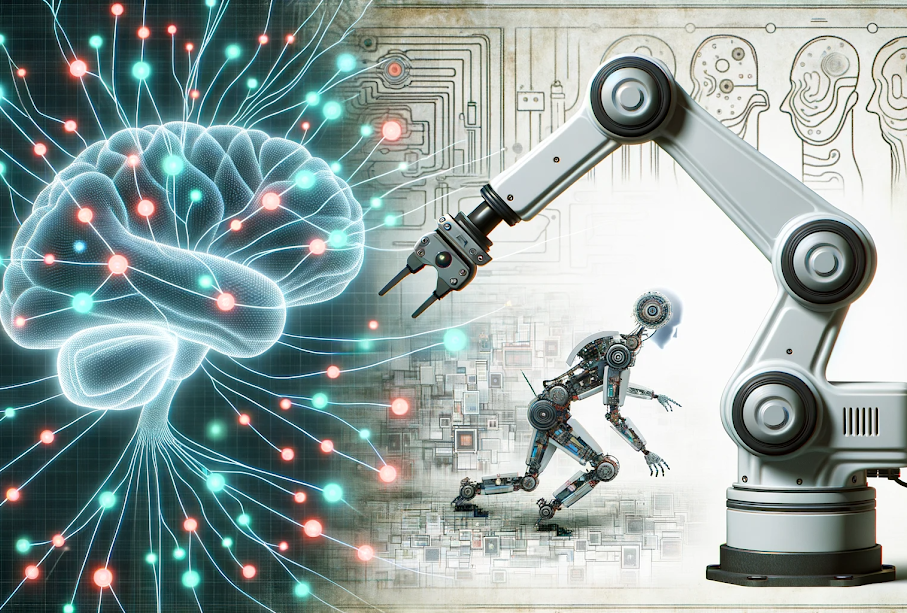In a paper published in the journal Biomimetics, researchers explored a novel approach to robot arm motion control, addressing the challenges faced by traditional inverse kinematics-based methods. These conventional methods often need help to adapt to the increasing complexity and diversity of robot environments due to their reliance on the precision of physical models.
 Study: Innovative Robot Arm Motion Control: An Inner Rehearsal-Based Approach. Image credit: Generated using DALL.E.3
Study: Innovative Robot Arm Motion Control: An Inner Rehearsal-Based Approach. Image credit: Generated using DALL.E.3
The authors proposed an innovative concept inspired by the cognitive mechanism of inner rehearsal observed in humans, which empowers robots to predict or evaluate the outcomes of motion commands before execution. This approach enhances the efficiency of model learning and reduces the mechanical wear on robots caused by frequent physical executions. The research involved experiments involving the Baxter robot in simulation and the humanoid robot Peking University Humanoid Robot 6.0 (PKU-HR6.0 II) in a natural environment, demonstrating the effectiveness and efficiency of this approach for robot arms reaching across different platforms. The results showed that internal models converged quickly, reducing the average error distance between the target and the end-effector on the two platforms.
Prior Research and Context
Robot arm reaching is an essential ability in humanoid robots and industrial automation. Traditional methods based on inverse kinematics face challenges in complex and unstructured environments due to their dependence on mechanical accuracy. Past works in robot arm reaching include visual servoing, learning-based internal models, and inner rehearsal. Visual servoing employs visual feedback for tasks and trajectory tracking. Learning-based internal models use neural networks for cognitive robot control, while inner rehearsal predicts command results before execution.
Proposed Framework Overview
The comprehensive robot arm-reaching framework comprises four integral blocks: visual information processing, target-driven planning, inner rehearsal, and command execution. The journey begins with perceiving the target's position in Cartesian space, translating visual input into intrinsic motivation to generate the target. The relative end-effector and target positions determine motion intent. The inverse model produces motion commands based on the current arm state and desired movement, ultimately leading to a sequence of planned commands executed by the robot.
Next, the establishment of internal models is explored, comprising forward and inverse models. These models serve to map joint angles to the robot's body state. In a two-stage learning process, initial training occurs using a coarse forward kinematics (FK) model in a simulation environment. This phase focuses on self-exploration and data collection. Subsequently, in the second stage, the internal models are fine-tuned using sensorimotor data collected from the real-world interactions of the robot. Visual feedback is pivotal in optimizing the inverse model, reducing the need for extensive training on actual robots and minimizing mechanical wear and tear.
Creating internal models includes generating motion commands that adjust to task requirements. Considering the relative position between the end-effector and the target accomplishes this adjustment. Rather than selecting from six basic directions, as in previous models, the proposed method generates arm movements based on relative position, ensuring smoother and more precise reaching trajectories. Moreover, individual models for each robot arm joint divide internal models and combine to create a whole-arm manipulation approach.
Finally, based on inner rehearsal, the motion planning process offers two stages: proprioception-based rough reaching and visual-feedback-based iterative adjustments. The robot employs internal rehearsal to predict the outcomes of motion commands, enabling more efficient and robust reaching. In the rough-reaching phase, vision guides the robot to determine the target's position and generate appropriate motion commands. The iterative adjustment phase involves a closed-loop control system, using visual feedback for further precision. They simplify the graphic processing by processing the image in the Hue, Saturation, Value (HSV), and depth space to extract the essential target information and encode it as a Cartesian position.
Empirical Findings
Researchers evaluated the efficacy of the proposed approach through experiments on two robot platforms: the Baxter robot, equipped with its left arm, and the humanoid robot PKU-HR6.0 II. To track the end-effector's position, the researchers added a red mark. The Baxter robot is a two-armed industrial robot, while PKU-HR6.0 II, 58.56 cm tall and 4.23 kg in weight, offers 28 Degrees of Freedom (DoFs). The inner rehearsal-based robot arm reaching approach is first validated in a preliminary simulation on the Baxter and subsequently tested on the PKU-HR6.0 II in a real-world environment. Marking the object in green and the end-effector in red improves visual sensing accuracy, simplifying target recognition and end-effector tracking.
The experiments demonstrate that inner rehearsal significantly enhances the performance of both robotic platforms, leading to smoother motion trajectories and reduced distances between the end-effector and the target. The experiments further reveal the advantages of inner rehearsal-based motion planning, particularly when coupled with model fine-tuning. This approach leads to improved reaching accuracy in the natural environment. It allows for smoother and more efficient motion trajectories, demonstrating the effectiveness of incorporating human cognitive mechanisms into robotic motion planning.
Summary
To sum up, this paper introduces a robot arm-reaching approach based on inner rehearsal, featuring a two-stage learning process for internal models. Initial pre-training with a coarse FK model is followed by fine-tuning in real-world conditions, enhancing learning efficiency and durability. Motion planning, driven by inner rehearsal, splits into proprioception-based rough-reaching planning and visual-feedback-based iterative adjustment planning, ultimately elevating reaching precision. Experimental results validate the method's effectiveness in robot arm-reaching tasks.
While the present work establishes a two-stage framework for robotic arm operation, future research can explore integrating human cognitive mechanisms to enhance adaptability in diverse, complex scenarios, promising advancements in robot learning and decision-making capabilities and expanding their seamless integration across a wide range of applications.